A Novel GIS-Based Random Forest Machine Algorithm for the Spatial Prediction of Shallow Landslide Susceptibility
Abstract
1. Introduction
2. The Study Area and the Landslide Inventory
2.1. General Description of the Study Area
2.2. Landslide Inventory Map
2.3. Landslide Conditioning Factors
2.4. Investigation on the Importance of the Landslide Conditioning Factors
3. Research Methodology
3.1. Random Forest Classifier
3.2. Support Vector Machine (SVM)
4. The Proposed Random Forest Machine (RFM) for GIS-Based Landslide Susceptibility Prediction
- (i)
- If all the training data points in a node belong to the same class, then the node label is assigned as the data label;
- (ii)
- If there are different labels in a node, the SVM structure is used to classify the data stored in this node.
5. Experimental Results
6. Conclusions
Author Contributions
Funding
Conflicts of Interest
References
- WHO. LANDSLIDES—Technical Hazard Sheet—Natural Disaster Profiles. Available online: https://www.who.int/hac/techguidance/ems/landslides/en/ (accessed on 5 September 2019).
- Haque, U.; Da Silva, P.F.; Devoli, G.; Pilz, J.; Zhao, B.; Khaloua, A.; Wilopo, W.; Andersen, P.; Lu, P.; Lee, J.; et al. The human cost of global warming: Deadly landslides and their triggers (1995–2014). Sci. Total Environ. 2019, 682, 673–684. [Google Scholar] [CrossRef] [PubMed]
- Hoa, T.X. Landslide Risks Located in Ten Northern Mountainous Localities; Institute of Geosciences and Mineral Resources under Ministry of Natural Resources and Environment: Hanoi, Vietnam, 2019.
- Reichenbach, P.; Rossi, M.; Malamud, B.D.; Mihir, M.; Guzzetti, F. A review of statistically-based landslide susceptibility models. Earth-Sci. Rev. 2018, 180, 60–91. [Google Scholar] [CrossRef]
- Hansen, A.; Franks, C.A.M.; Kirk, P.A.; Brimicombe, A.J.; Tung, F. Application of GIS to Hazard Assessment, with Particular Reference to Landslides in Hong Kong. In Geographical Information Systems in Assessing Natural Hazards; Carrara, A., Guzzetti, F., Eds.; Springer: Dordrecht, The Netherlands, 1995; pp. 273–298. [Google Scholar]
- Montrasio, L.; Valentino, R.; Meisina, C. Soil Saturation and Stability Analysis of a Test Site Slope Using the Shallow Landslide Instability Prediction (SLIP) Model. Geotech. Geol. Eng. 2018, 36, 2331–2342. [Google Scholar] [CrossRef]
- Cheng, M.-Y.; Hoang, N.-D. Slope Collapse Prediction Using Bayesian Framework with K-Nearest Neighbor Density Estimation: Case Study in Taiwan. J. Comput. Civ. Eng. 2016, 30, 04014116. [Google Scholar] [CrossRef]
- Reichenbach, P.; Galli, M.; Cardinali, M.; Guzzetti, F.; Ardizzone, F. Geomorphological Mapping to Assess Landslide Risk: Concepts, Methods and Applications in the Umbria Region of Central Italy. In Landslide Hazard and Risk; John Wiley: Chichester, UK, 2005; pp. 429–468. [Google Scholar]
- Mejía-Navarro, M.; Wohl, E.E.; Oaks, S.D. Geological hazards, vulnerability, and risk assessment using GIS: Model for Glenwood Springs, Colorado. Geomorphology 1994, 10, 331–354. [Google Scholar] [CrossRef]
- Wang, Y.; Fang, Z.; Hong, H. Comparison of convolutional neural networks for landslide susceptibility mapping in Yanshan County, China. Sci. Total Environ. 2019, 666, 975–993. [Google Scholar] [CrossRef]
- Kavzoglu, T.; Colkesen, I.; Sahin, E.K. Machine Learning Techniques in Landslide Susceptibility Mapping: A Survey and a Case Study. In Landslides: Theory, Practice and Modelling; Pradhan, S.P., Vishal, V., Singh, T.N., Eds.; Springer International Publishing: Cham, Switzerland, 2019; pp. 283–301. [Google Scholar]
- Alvioli, M.; Baum, R.L. Parallelization of the TRIGRS model for rainfall-induced landslides using the message passing interface. Environ. Model. Softw. 2016, 81, 122–135. [Google Scholar] [CrossRef]
- Anagnostopoulos, G.G.; Fatichi, S.; Burlando, P. An advanced process-based distributed model for the investigation of rainfall-induced landslides: The effect of process representation and boundary conditions. Water Resour. Res. 2015, 51, 7501–7523. [Google Scholar] [CrossRef]
- Montgomery, D.R.; Dietrich, W.E. A physically based model for the topographic control on shallow landsliding. Water Resour. Res. 1994, 30, 1153–1171. [Google Scholar] [CrossRef]
- Bui, D.T.; Hoang, N.-D.; Nguyen, H.; Tran, X.-L. Spatial prediction of shallow landslide using Bat algorithm optimized machine learning approach: A case study in Lang Son Province, Vietnam. Adv. Eng. Inform. 2019, 42, 100978. [Google Scholar]
- Pham, B.T.; Jaafari, A.; Prakash, I.; Bui, D.T. A novel hybrid intelligent model of support vector machines and the MultiBoost ensemble for landslide susceptibility modeling. Bull. Eng. Geol. Environ. 2019, 78, 2865–2886. [Google Scholar] [CrossRef]
- Park, S.-J.; Lee, C.-W.; Lee, S.; Lee, M.-J. Landslide Susceptibility Mapping and Comparison Using Decision Tree Models: A Case Study of Jumunjin Area, Korea. Remote Sens. 2018, 10, 1545. [Google Scholar] [CrossRef]
- Lombardo, L.; Mai, P.M. Presenting logistic regression-based landslide susceptibility results. Eng. Geol. 2018, 244, 14–24. [Google Scholar] [CrossRef]
- Polykretis, C.; Chalkias, C.; Ferentinou, M. Adaptive neuro-fuzzy inference system (ANFIS) modeling for landslide susceptibility assessment in a Mediterranean hilly area. Bull. Eng. Geol. Environ. 2019, 78, 1173–1187. [Google Scholar] [CrossRef]
- Zhu, A.X.; Miao, Y.; Liu, J.; Bai, S.; Zeng, C.; Ma, T.; Hong, H. A similarity-based approach to sampling absence data for landslide susceptibility mapping using data-driven methods. Catena 2019, 183, 104188. [Google Scholar] [CrossRef]
- Aditian, A.; Kubota, T.; Shinohara, Y. Comparison of GIS-based landslide susceptibility models using frequency ratio, logistic regression, and artificial neural network in a tertiary region of Ambon, Indonesia. Geomorphology 2018, 318, 101–111. [Google Scholar] [CrossRef]
- Hemasinghe, H.; Rangali, R.S.S.; Deshapriya, N.L.; Samarakoon, L. Landslide susceptibility mapping using logistic regression model (a case study in Badulla District, Sri Lanka). Procedia Eng. 2018, 212, 1046–1053. [Google Scholar] [CrossRef]
- Kalantar, B.; Pradhan, B.; Naghibi, S.A.; Motevalli, A.; Mansor, S. Assessment of the effects of training data selection on the landslide susceptibility mapping: A comparison between support vector machine (SVM), logistic regression (LR) and artificial neural networks (ANN). Geomat. Nat. Hazards Risk 2018, 9, 49–69. [Google Scholar] [CrossRef]
- Abedini, M.; Ghasemian, B.; Shirzadi, A.; Shahabi, H.; Chapi, K.; Pham, B.T.; Bin Ahmad, B.; Tien Bui, D. A novel hybrid approach of Bayesian Logistic Regression and its ensembles for landslide susceptibility assessment. Geocarto Int. 2018, 34, 1427–1457. [Google Scholar] [CrossRef]
- Chen, W.; Xie, X.; Wang, J.; Pradhan, B.; Hong, H.; Bui, D.T.; Duan, Z.; Ma, J. A comparative study of logistic model tree, random forest, and classification and regression tree models for spatial prediction of landslide susceptibility. Catena 2017, 151, 147–160. [Google Scholar] [CrossRef]
- Polykretis, C.; Chalkias, C. Comparison and evaluation of landslide susceptibility maps obtained from weight of evidence, logistic regression, and artificial neural network models. Nat. Hazards 2018, 93, 249–274. [Google Scholar]
- Jaafari, A.; Panahi, M.; Pham, B.T.; Shahabi, H.; Bui, D.T.; Rezaie, F.; Lee, S. Meta optimization of an adaptive neuro-fuzzy inference system with grey wolf optimizer and biogeography-based optimization algorithms for spatial prediction of landslide susceptibility. Catena 2019, 175, 430–445. [Google Scholar] [CrossRef]
- Ada, M.; San, B.T. Comparison of machine-learning techniques for landslide susceptibility mapping using two-level random sampling (2LRS) in Alakir catchment area, Antalya, Turkey. Nat. Hazards 2018, 90, 237–263. [Google Scholar] [CrossRef]
- Alkhasawneh, M.S.; Ngah, U.K.; Tay, L.T.; Isa, N.A.M.; Al-Batah, M.S. Modeling and Testing Landslide Hazard Using Decision Tree. J. Appl. Math. 2014, 2014, 9. [Google Scholar] [CrossRef]
- Kadavi, P.R.; Lee, C.-W.; Lee, S. Application of Ensemble-Based Machine Learning Models to Landslide Susceptibility Mapping. Remote Sens. 2018, 10, 1252. [Google Scholar] [CrossRef]
- Hong, H.; Liu, J.; Bui, D.T.; Pradhan, B.; Acharya, T.D.; Pham, B.T.; Zhu, A.X.; Chen, W.; Ahmad, B.B. Landslide susceptibility mapping using J48 Decision Tree with AdaBoost, Bagging and Rotation Forest ensembles in the Guangchang area (China). Catena 2018, 163, 399–413. [Google Scholar] [CrossRef]
- Nguyen, Q.-K.; Bui, D.T.; Hoang, N.-D.; Trinh, P.T.; Nguyen, V.-H.; Yilmaz, I. A Novel Hybrid Approach Based on Instance Based Learning Classifier and Rotation Forest Ensemble for Spatial Prediction of Rainfall-Induced Shallow Landslides using GIS. Sustainability 2017, 9, 813. [Google Scholar] [CrossRef]
- Juliev, M.; Mergili, M.; Mondal, I.; Nurtaev, B.; Pulatov, A.; Hübl, J. Comparative analysis of statistical methods for landslide susceptibility mapping in the Bostanlik District, Uzbekistan. Sci. Total Environ. 2019, 653, 801–814. [Google Scholar] [CrossRef]
- Bragagnolo, L.; Silva, R.V.D.; Grzybowski, J.M.V. Artificial neural network ensembles applied to the mapping of landslide susceptibility. Catena 2020, 184, 104240. [Google Scholar] [CrossRef]
- Choubin, B.; Abdolshahnejad, M.; Moradi, E.; Querol, X.; Mosavi, A.; Shamshirband, S.; Ghamisi, P. Spatial hazard assessment of the PM10 using machine learning models in Barcelona, Spain. Sci. Total Environ. 2020, 701, 134474. [Google Scholar] [CrossRef]
- Choubin, B.; Mosavi, A.; Alamdarloo, E.H.; Hosseini, F.S.; Shamshirband, S.; Dashtekian, K.; Ghamisi, P. Earth fissure hazard prediction using machine learning models. Environ. Res. 2019, 179, 108770. [Google Scholar] [CrossRef] [PubMed]
- Choubin, B.; Borji, M.; Mosavi, A.; Sajedi-Hosseini, F.; Singh, V.P.; Shamshirband, S. Snow avalanche hazard prediction using machine learning methods. J. Hydrol. 2019, 577, 123929. [Google Scholar] [CrossRef]
- Rahmati, O.; Ghorbanzadeh, O.; Teimurian, T.; Mohammadi, F.; Tiefenbacher, J.P.; Falah, F.; Pirasteh, S.; Ngo, P.T.T.; Bui, D.T. Spatial Modeling of Snow Avalanche Using Machine Learning Models and Geo-Environmental Factors: Comparison of Effectiveness in Two Mountain Regions. Remote Sens. 2019, 11, 2995. [Google Scholar] [CrossRef]
- Rahmati, O.; Yousefi, S.; Kalantari, Z.; Uuemaa, E.; Teimurian, T.; Keesstra, S.; Pham, T.D.; Tien Bui, D. Multi-hazard exposure mapping using machine learning techniques: A case study from Iran. Remote Sens. 2019, 11, 1943. [Google Scholar] [CrossRef]
- Rahmati, O.; Choubin, B.; Fathabadi, A.; Coulon, F.; Soltani, E.; Shahabi, H.; Mollaefar, E.; Tiefenbacher, J.; Cipullo, S.; Ahmad, B.B.; et al. Predicting uncertainty of machine learning models for modelling nitrate pollution of groundwater using quantile regression and UNEEC methods. Sci. Total Environ. 2019, 688, 855–866. [Google Scholar] [CrossRef] [PubMed]
- Bui, D.T.; Hoang, N.D.; Martínez-Álvarez, F.; Ngo, P.T.T.; Hoa, P.V.; Pham, T.D.; Samui, P.; Costache, R. A novel deep learning neural network approach for predicting flash flood susceptibility: A case study at a high frequency tropical storm area. Sci. Total Environ. 2020, 701, 134413. [Google Scholar]
- Bui, D.T.; Hoang, N.D.; Pham, T.D.; Ngo, P.T.T.; Hoa, P.V.; Minh, N.Q.; Tran, X.T.; Samui, P. A new intelligence approach based on GIS-based Multivariate Adaptive Regression Splines and metaheuristic optimization for predicting flash flood susceptible areas at high-frequency tropical typhoon area. J. Hydrol. 2019, 575, 314–326. [Google Scholar]
- Tien Bui, D.; Tsangaratos, P.; Nguyen, V.T.; Van Liem, N.; Trinh, P.T. Comparing the prediction performance of a Deep Learning Neural Network model with conventional machine learning models in landslide susceptibility assessment. Catena 2019, 188, 104426. [Google Scholar]
- Dou, J.; Yunus, A.P.; Bui, D.T.; Merghadi, A.; Sahana, M.; Zhu, Z.; Chen, C.W.; Khosravi, K.; Yang, Y.; Pham, B.T. Assessment of advanced random forest and decision tree algorithms for modeling rainfall-induced landslide susceptibility in the Izu-Oshima Volcanic Island, Japan. Sci. Total Environ. 2019, 662, 332–346. [Google Scholar] [CrossRef]
- Ho, T.K. Random decision forests. In Proceedings of the 3rd International Conference on Document Analysis and Recognition, Montreal, QC, Canada, 14–16 August 1995; Volume 1, pp. 278–282. [Google Scholar]
- Breiman, L. Random Forests. Mach. Learn. 2001, 45, 5–32. [Google Scholar] [CrossRef]
- Vapnik, V.N. Statistical Learning Theory; John Wiley & Sons, Inc.: New York, NY, USA, 1998; ISBN 0471030031. [Google Scholar]
- Boser, B.E.; Guyon, I.M.; Vapnik, V.N. A training algorithm for optimal margin classifiers. In Proceedings of the Fifth Annual Workshop on Computational Learning Theory, Pittsburgh, PA, USA, 27–29 July 1992. [Google Scholar]
- Dang, V.-H.; Dieu, T.B.; Tran, X.-L.; Hoang, N.-D. Enhancing the accuracy of rainfall-induced landslide prediction along mountain roads with a GIS-based random forest classifier. Bull. Eng. Geol. Environ. 2018, 78, 2835–2849. [Google Scholar] [CrossRef]
- Chen, W.; Pourghasemi, H.R.; Naghibi, S.A. A comparative study of landslide susceptibility maps produced using support vector machine with different kernel functions and entropy data mining models in China. Bull. Eng. Geol. Environ. 2008, 77, 647–664. [Google Scholar] [CrossRef]
- Huang, Y.; Zhao, L. Review on landslide susceptibility mapping using support vector machines. Catena 2018, 165, 520–529. [Google Scholar] [CrossRef]
- Tien Bui, D.; Shahabi, H.; Shirzadi, A.; Chapi, K.; Hoang, N.D.; Pham, B.; Bui, Q.T.; Tran, C.T.; Panahi, M.; Bin Ahamd, B.; et al. A Novel Integrated Approach of Relevance Vector Machine Optimized by Imperialist Competitive Algorithm for Spatial Modeling of Shallow Landslides. Remote Sens. 2018, 10, 1538. [Google Scholar] [CrossRef]
- Tam, V.T.; Tuy, P.K.; Nam, N.X.; Tuan, L.C.; Tuan, N.D.; Trung, N.D.; Thang, D.V.; Ha, P.V. Geohazard Investigation in Some Key Areas of the Northern Mountainous Area of Vietnam for the Planning of Socio-Economic Development Vietnam; Technical Report; Institute of Geosciences and Mineral Resources: Hanoi, Vietnam, 2006; Volume 83, pp. 56–62. [Google Scholar]
- Hearn, G.J.; Hart, A.B. Landslide susceptibility mapping: A practitioner’s view. Bull. Eng. Geol. Environ. 2019. [Google Scholar] [CrossRef]
- Pham, B.T.; Bui, D.T.; Pourghasemi, H.R.; Indra, P.; Dholakia, M.B. Landslide susceptibility assesssment in the Uttarakhand area (India) using GIS: A comparison study of prediction capability of naïve bayes, multilayer perceptron neural networks, and functional trees methods. Theor. Appl. Climatol. 2017, 128, 255–273. [Google Scholar] [CrossRef]
- Chen, W.; Panahi, M.; Pourghasemi, H.R. Performance evaluation of GIS-based new ensemble data mining techniques of adaptive neuro-fuzzy inference system (ANFIS) with genetic algorithm (GA), differential evolution (DE), and particle swarm optimization (PSO) for landslide spatial modelling. Catena 2017, 157, 310–324. [Google Scholar] [CrossRef]
- North, M.A. A Method for Implementing a Statistically Significant Number of Data Classes in the Jenks Algorithm. In Proceedings of the Sixth International Conference on Fuzzy Systems and Knowledge Discovery, Tianjin, China, 14–16 August 2009; Volume 1, pp. 35–38. [Google Scholar]
- Hung, L.; Van, N.; Duc, D.; Ha, L.; Son, P.; Khanh, N.; Binh, L. Landslide susceptibility mapping by combining the analytical hierarchy process and weighted linear combination methods: A case study in the upper Lo River catchment (Vietnam). Landslides 2016, 13, 1285–1301. [Google Scholar] [CrossRef]
- Robnik-Šikonja, M.; Kononenko, I. Theoretical and Empirical Analysis of ReliefF and RReliefF. Mach. Learn. 2003, 53, 23–69. [Google Scholar] [CrossRef]
- Kuncheva, L.I. Combining Pattern Classifiers: Methods and Algorithms; John Wiley & Sons, Inc.: New York, NY, USA, 2014. [Google Scholar]
- Kleinberg, E.M. Stochastic discrimination. Ann. Math. Artif. Intell. 1990, 1, 207–239. [Google Scholar] [CrossRef]
- Arabameri, A.; Yamani, M.; Pradhan, B.; Melesse, A.; Shirani, K.; Bui, D.T. Novel ensembles of COPRAS multi-criteria decision-making with logistic regression, boosted regression tree, and random forest for spatial prediction of gully erosion susceptibility. Sci. Total Environ. 2019, 688, 903–916. [Google Scholar] [CrossRef]
- Sun, Z.; Sun, H.; Zhang, J. Multistep Wind Speed and Wind Power Prediction Based on a Predictive Deep Belief Network and an Optimized Random Forest. Math. Probl. Eng. 2018, 2018, 15. [Google Scholar] [CrossRef]
- Kim, J.-C.; Lee, S.; Jung, H.-S.; Lee, S. Landslide susceptibility mapping using random forest and boosted tree models in Pyeong-Chang, Korea. Geocarto Int. 2018, 33, 1000–1015. [Google Scholar] [CrossRef]
- Trigila, A.; Iadanza, C.; Esposito, C.; Scarascia-Mugnozza, G. Comparison of Logistic Regression and Random Forests techniques for shallow landslide susceptibility assessment in Giampilieri (NE Sicily, Italy). Geomorphology 2015, 249, 119–136. [Google Scholar] [CrossRef]
- Chen, W.; Xie, X.; Peng, J.; Shahabi, H.; Hong, H.; Bui, D.T.; Duan, Z.; Li, S.; Zhu, A.X. GIS-based landslide susceptibility evaluation using a novel hybrid integration approach of bivariate statistical based random forest method. Catena 2018, 164, 135–149. [Google Scholar] [CrossRef]
- Rokach, L.; Maimon, O. Datamining and Knowledge Discovery Handbook; Springer: Boston, MA, USA, 2010. [Google Scholar]
- Bonissone, P.; Cadenas, J.M.; Garrido, M.C.; Díaz-Valladares, R.A. A fuzzy random forest. Int. J. Approx. Reason. 2010, 51, 729–747. [Google Scholar] [CrossRef]
- Tehrany, M.S.; Pradhan, B.; Mansor, S.; Ahmad, N. Flood susceptibility assessment using GIS-based support vector machine model with different kernel types. Catena 2015, 125, 91–101. [Google Scholar] [CrossRef]
- Sachdeva, S.; Bhatia, T.; Verma, A.K. Flood susceptibility mapping using GIS-based support vector machine and particle swarm optimization: A case study in Uttarakhand (India). In Proceedings of the 2017 8th International Conference on Computing, Communication and Networking Technologies (ICCCNT), Delhi, India, 3–5 July 2017; pp. 1–7. [Google Scholar]
- Deo, R.C.; Kisi, O.; Singh, V.P. Drought forecasting in eastern Australia using multivariate adaptive regression spline, least square support vector machine and M5Tree model. Atmos. Res. 2017, 184, 149–175. [Google Scholar] [CrossRef]
- Choubin, B.; Moradi, E.; Golshan, M.; Adamowski, J.; Sajedi-Hosseini, F.; Mosavi, A. An Ensemble prediction of flood susceptibility using multivariate discriminant analysis, classification and regression trees, and support vector machines. Sci. Total Environ. 2019, 651, 2087–2096. [Google Scholar] [CrossRef] [PubMed]
- Yao, X.; Tham, L.; Dai, F. Landslide susceptibility mapping based on support vector machine: A case study on natural slopes of Hong Kong, China. Geomorphology 2008, 101, 572–582. [Google Scholar] [CrossRef]
- Pradhan, B. A comparative study on the predictive ability of the decision tree, support vector machine and neuro-fuzzy models in landslide susceptibility mapping using GIS. Comput. Geosci. 2013, 51, 350–365. [Google Scholar] [CrossRef]
- Hoang, N.-D.; Nguyen, Q.-L.; Bui, D.T. Image Processing-Based Classification of Asphalt Pavement Cracks Using Support Vector Machine Optimized by Artificial Bee Colony. J. Comput. Civ. Eng. 2018, 32, 04018037. [Google Scholar] [CrossRef]
- Hoang, N.-D.; Bui, D.T. Predicting earthquake-induced soil liquefaction based on a hybridization of kernel Fisher discriminant analysis and a least squares support vector machine: A multi-dataset study. Bull. Eng. Geol. Environ. 2018, 77, 191–204. [Google Scholar] [CrossRef]
- Bui, D.T.; Tuan, A.T.; Klempe, H.; Pradhan, B.; Revhaug, I. Spatial prediction models for shallow landslide hazards: A comparative assessment of the efficacy of support vector machines, artificial neural networks, kernel logistic regression, and logistic model tree. Landslides 2016, 13, 361–378. [Google Scholar]
- Pham, B.T.; Pradhan, B.; Bui, D.T.; Prakash, I.; Dholakia, M. A comparative study of different machine learning methods for landslide susceptibility assessment: A case study of Uttarakhand area (India). Environ. Model. Softw. 2016, 84, 240–250. [Google Scholar] [CrossRef]
- Joshi, P.P.; Wynne, R.H.; Thomas, V.A. Cloud detection algorithm using SVM with SWIR2 and tasseled cap applied to Landsat 8. Int. J. Appl. Earth Obs. Geoinf. 2019, 82, 101898. [Google Scholar] [CrossRef]
- Sokolova, M.; Japkowicz, N.; Szpakowicz, S. Beyond accuracy, F-score and ROC: A family of discriminant measures for performance evaluation. In Proceedings of the Australasian Joint Conference on Artificial Intelligence, Hobart, Australia, 4–8 December 2006; Springer: Berlin/Heidelberg, Germany, 2006; pp. 1015–1021. [Google Scholar]
- Sasaki, Y. The truth of the F-measure. Teach Tutor Mater 2007, 26, 1–5. Available online: https://www.cs.odu.edu/~mukka/cs795sum09dm/Lecturenotes/Day3/F-measure-YS-26Oct07.pdf (accessed on 30 December 2019).
- Wang, L.-J.; Guo, M.; Sawada, K.; Lin, J.; Zhang, J. A comparative study of landslide susceptibility maps using logistic regression, frequency ratio, decision tree, weights of evidence and artificial neural network. Geosci. J. 2016, 20, 117–136. [Google Scholar] [CrossRef]
- Matwork. Statistics and Machine Learning Toolbox User’s Guide; Matwork Inc.: Natick, MA, USA, 2017; Available online: https://www.mathworks.com/help/pdf_doc/stats/stats.pdf (accessed on 4 August 2018).
- Hollander, M.; Wolfe, D.A. Nonparametric Statistical Methods; John Wiley & Sons: Hoboken, NJ, USA, 1999. [Google Scholar]
- Chung, C.-J.F.; Fabbri, A.G.; van Westen, C.J. Multivariate regression analysis for landslide hazard zonation. In Geographical Information Systems in Assessing Natural Hazards; Springer: Dordrecht, The Netherlands, 1995; pp. 107–133. [Google Scholar]


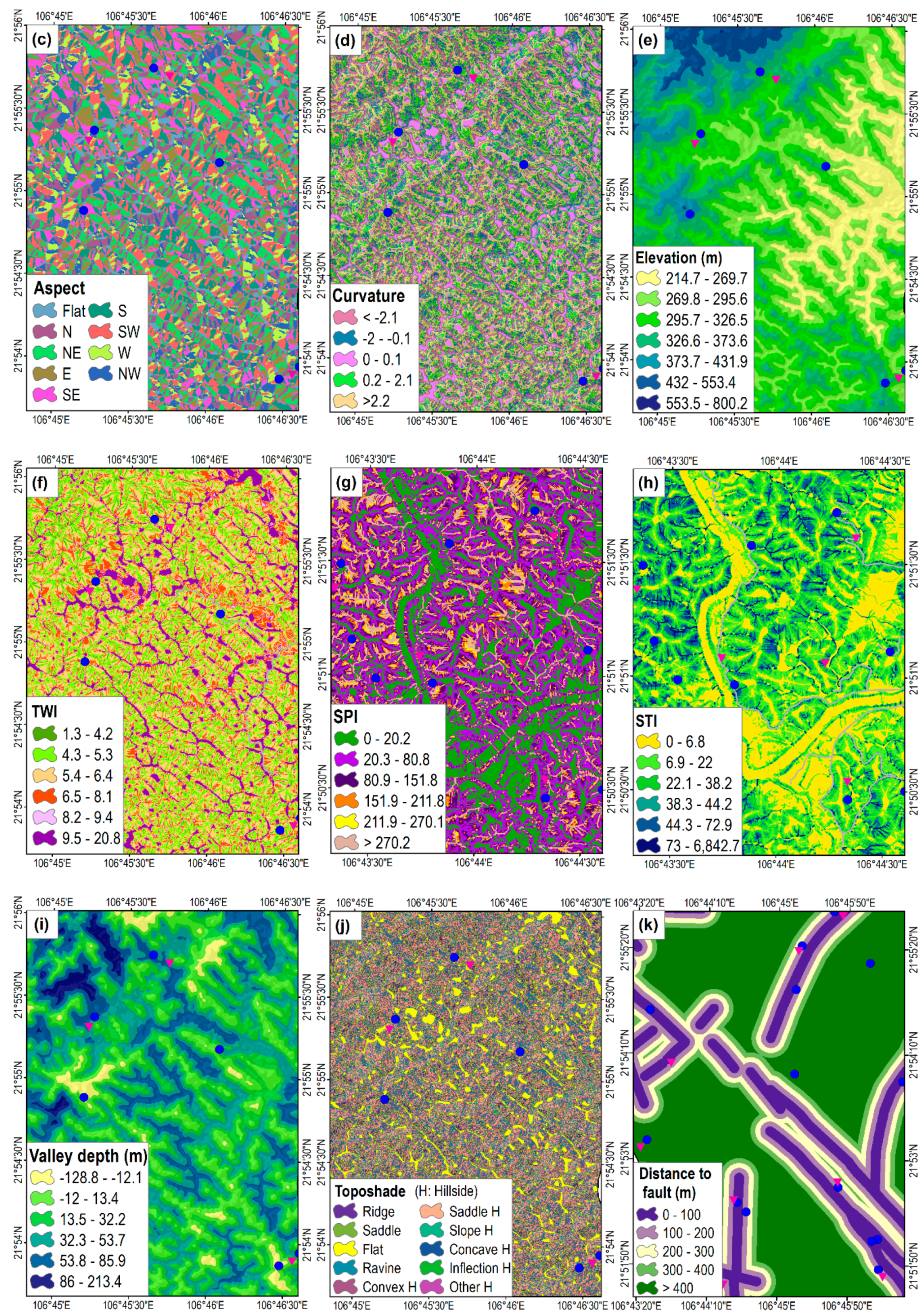

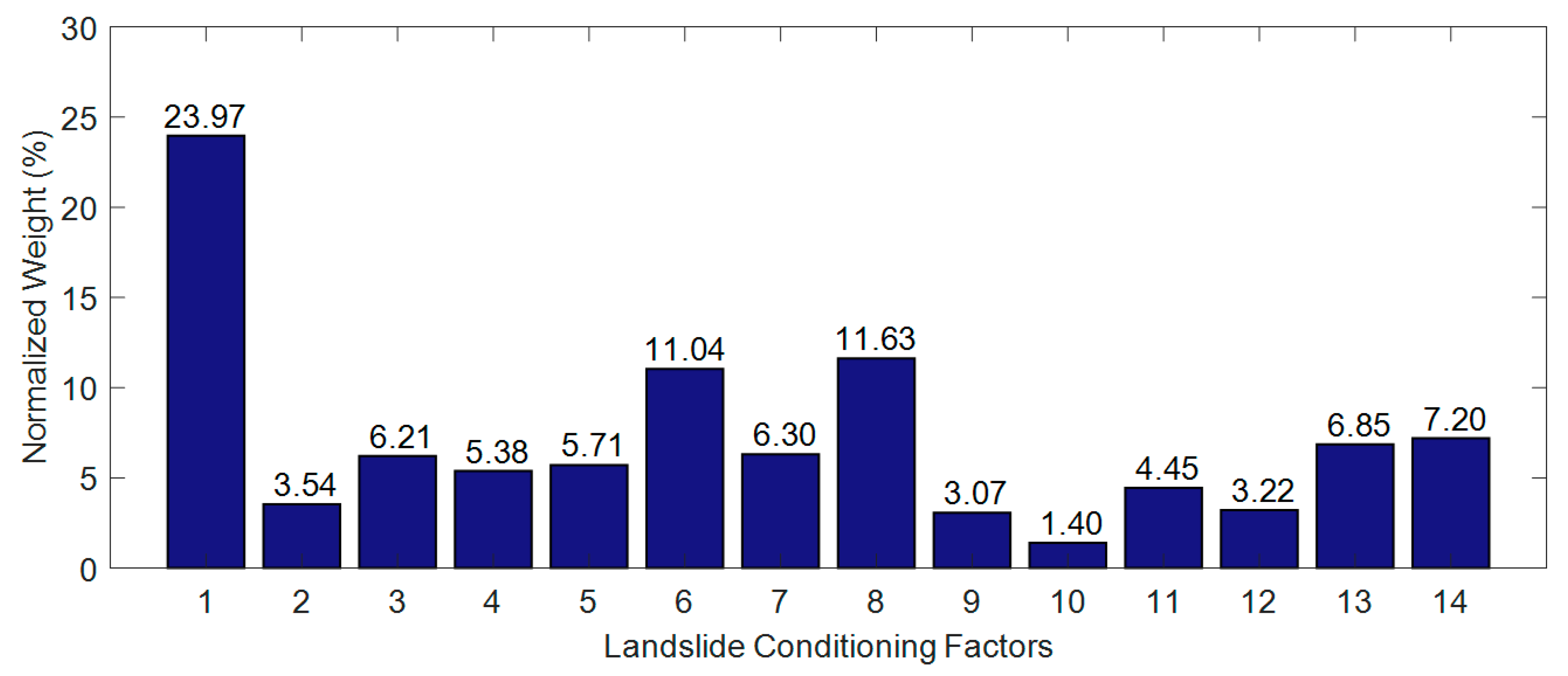
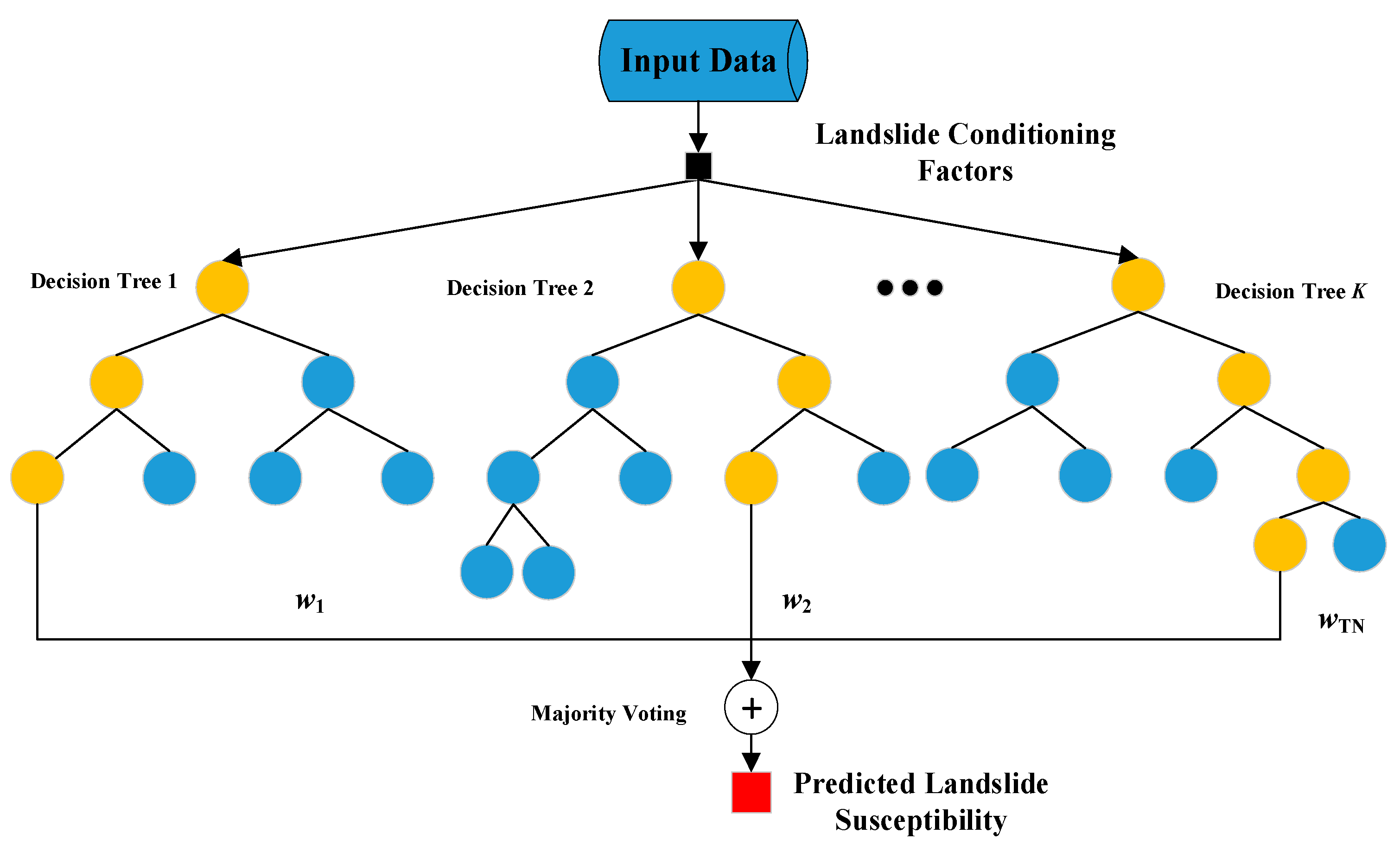
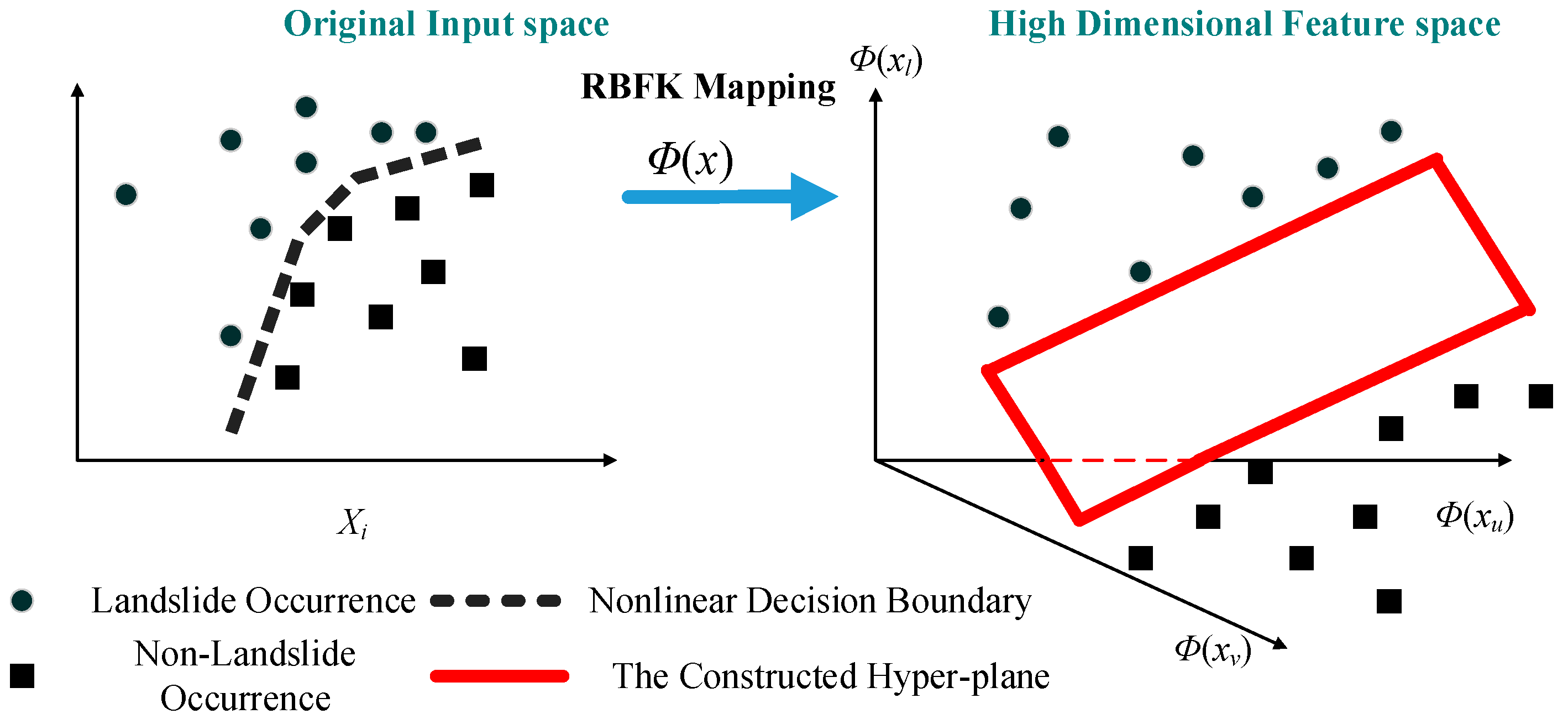

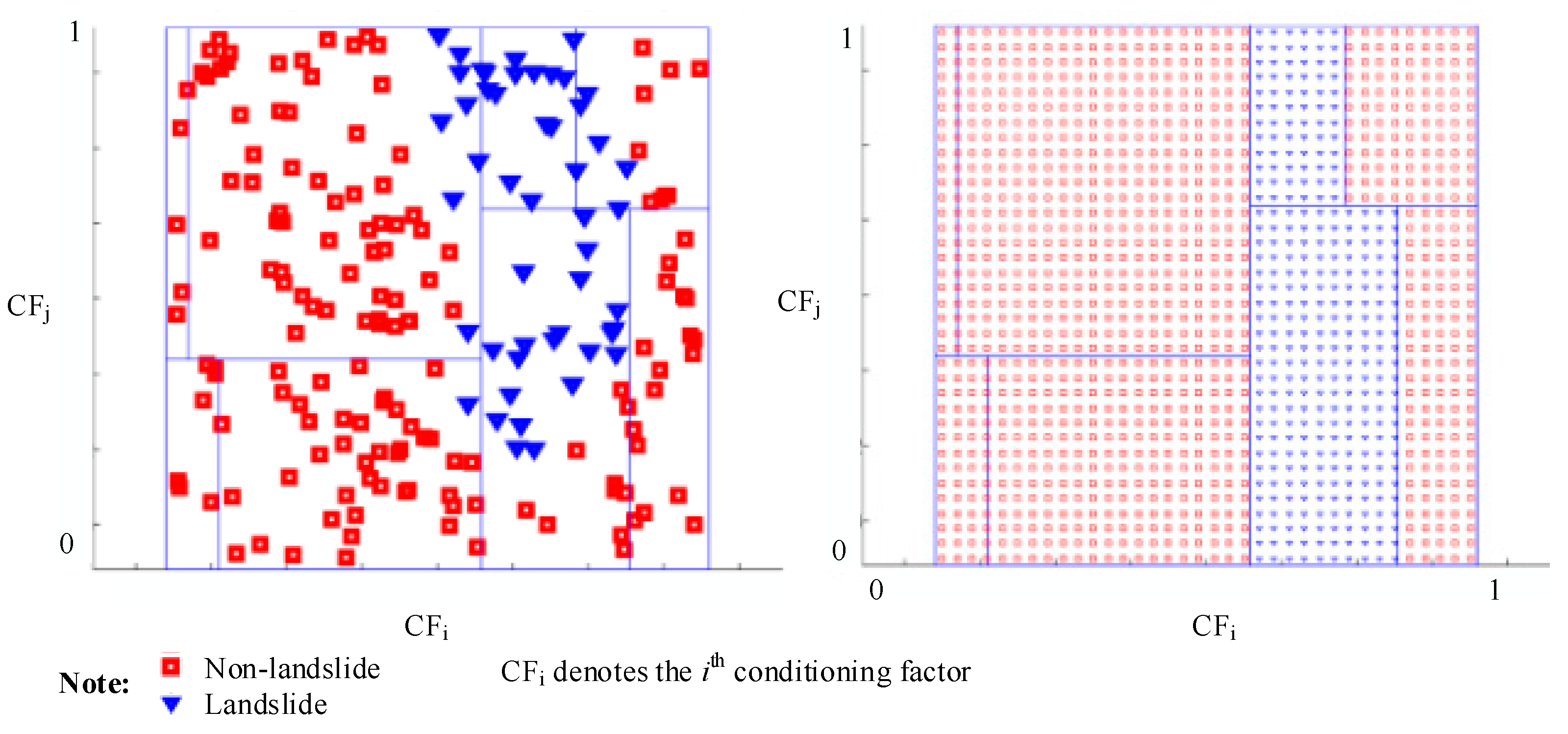

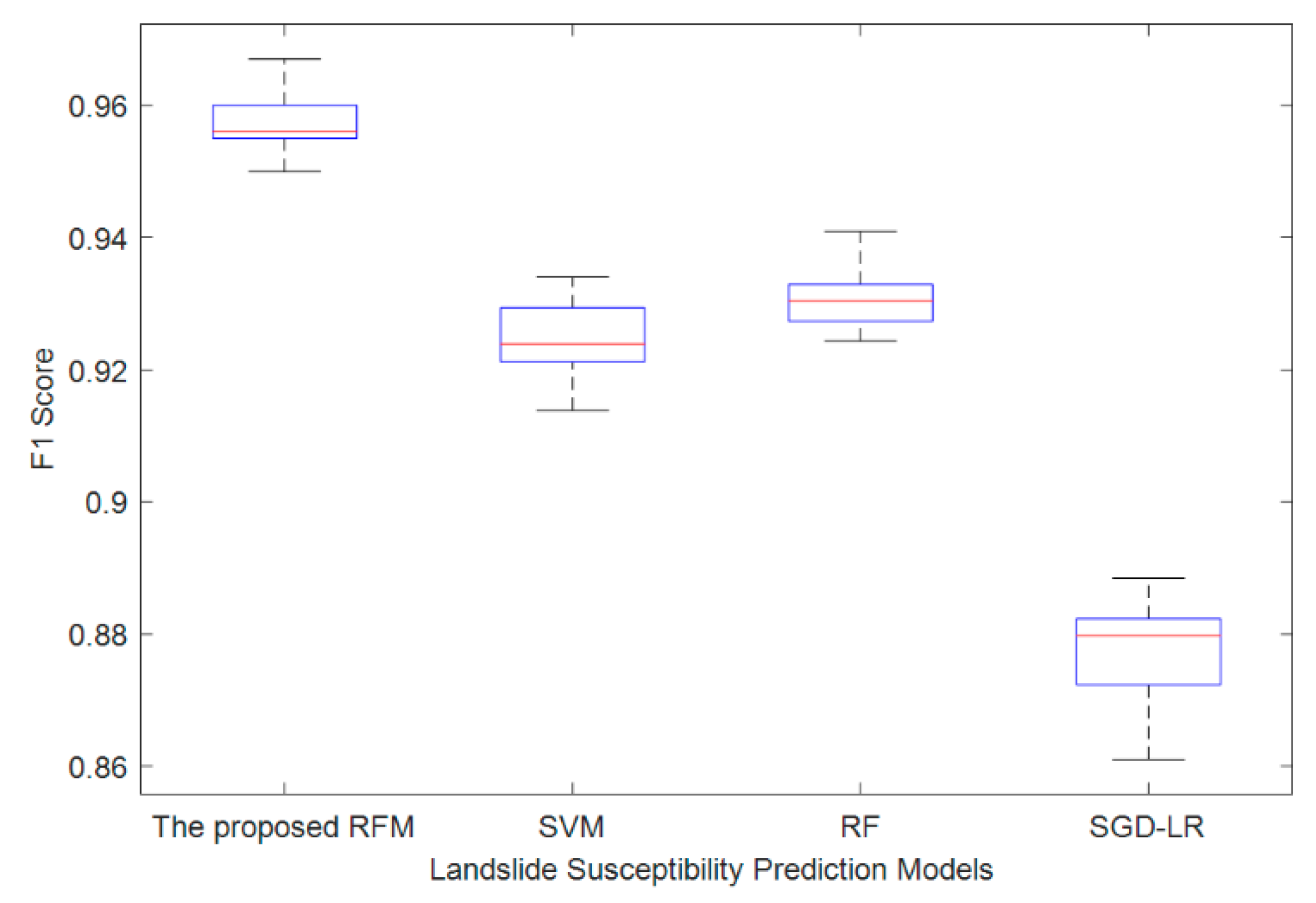
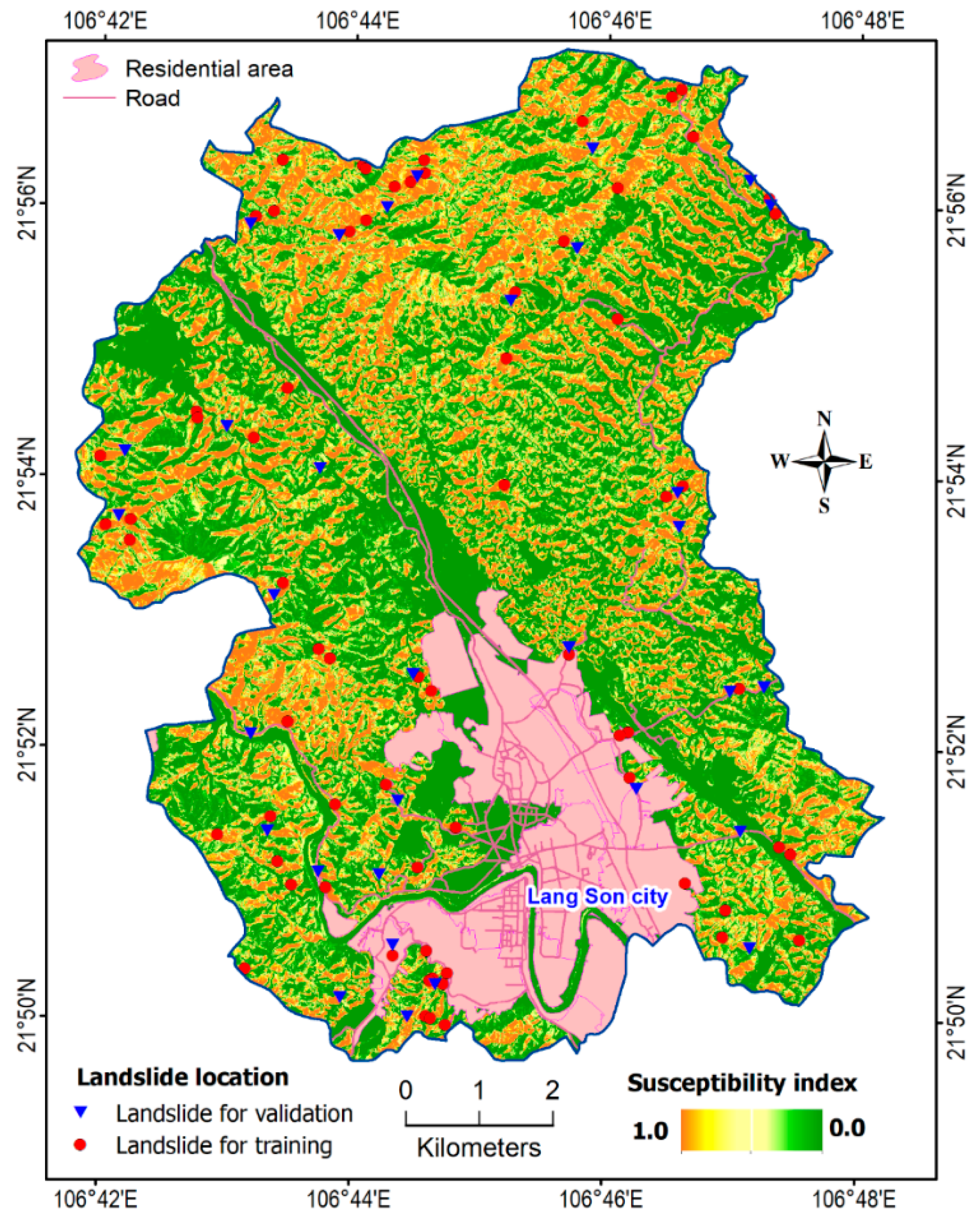
| Run No. | CAR | TPR | FPR | FNR | TNR | Precision | Recall | F1 Score |
|---|---|---|---|---|---|---|---|---|
| 1 | 0.965 | 0.945 | 0.013 | 0.055 | 0.987 | 0.988 | 0.945 | 0.966 |
| 2 | 0.969 | 0.949 | 0.009 | 0.051 | 0.991 | 0.991 | 0.949 | 0.970 |
| 3 | 0.969 | 0.951 | 0.012 | 0.049 | 0.988 | 0.989 | 0.951 | 0.970 |
| 4 | 0.965 | 0.944 | 0.012 | 0.056 | 0.988 | 0.989 | 0.944 | 0.966 |
| 5 | 0.967 | 0.948 | 0.013 | 0.052 | 0.987 | 0.988 | 0.948 | 0.968 |
| 6 | 0.966 | 0.945 | 0.012 | 0.055 | 0.988 | 0.988 | 0.945 | 0.966 |
| 7 | 0.967 | 0.949 | 0.012 | 0.051 | 0.988 | 0.989 | 0.949 | 0.969 |
| 8 | 0.965 | 0.946 | 0.014 | 0.054 | 0.986 | 0.986 | 0.946 | 0.966 |
| 9 | 0.969 | 0.950 | 0.011 | 0.050 | 0.989 | 0.990 | 0.950 | 0.970 |
| 10 | 0.963 | 0.941 | 0.013 | 0.059 | 0.987 | 0.988 | 0.941 | 0.964 |
| 11 | 0.969 | 0.949 | 0.010 | 0.051 | 0.990 | 0.990 | 0.949 | 0.969 |
| 12 | 0.967 | 0.947 | 0.012 | 0.053 | 0.988 | 0.988 | 0.947 | 0.967 |
| 13 | 0.966 | 0.945 | 0.010 | 0.055 | 0.990 | 0.990 | 0.945 | 0.967 |
| 14 | 0.967 | 0.948 | 0.011 | 0.052 | 0.989 | 0.990 | 0.948 | 0.969 |
| 15 | 0.966 | 0.945 | 0.011 | 0.055 | 0.989 | 0.990 | 0.945 | 0.967 |
| 16 | 0.969 | 0.952 | 0.012 | 0.048 | 0.988 | 0.988 | 0.952 | 0.970 |
| 17 | 0.968 | 0.948 | 0.010 | 0.052 | 0.990 | 0.991 | 0.948 | 0.969 |
| 18 | 0.965 | 0.946 | 0.015 | 0.054 | 0.985 | 0.986 | 0.946 | 0.966 |
| 19 | 0.967 | 0.946 | 0.012 | 0.054 | 0.988 | 0.988 | 0.946 | 0.967 |
| 20 | 0.968 | 0.949 | 0.012 | 0.051 | 0.988 | 0.989 | 0.949 | 0.969 |
| Mean | 0.967 | 0.947 | 0.012 | 0.053 | 0.988 | 0.989 | 0.947 | 0.968 |
| SD | 0.002 | 0.003 | 0.001 | 0.003 | 0.001 | 0.001 | 0.003 | 0.002 |
| CAR | TPR | FPR | FNR | TNR | Precision | Recall | F1 Score | |
|---|---|---|---|---|---|---|---|---|
| 1 | 0.954 | 0.934 | 0.024 | 0.066 | 0.976 | 0.978 | 0.934 | 0.956 |
| 2 | 0.960 | 0.939 | 0.017 | 0.061 | 0.983 | 0.984 | 0.939 | 0.961 |
| 3 | 0.962 | 0.941 | 0.016 | 0.059 | 0.984 | 0.985 | 0.941 | 0.963 |
| 4 | 0.950 | 0.920 | 0.015 | 0.080 | 0.985 | 0.986 | 0.920 | 0.952 |
| 5 | 0.957 | 0.932 | 0.014 | 0.068 | 0.986 | 0.987 | 0.932 | 0.959 |
| 6 | 0.953 | 0.929 | 0.019 | 0.071 | 0.981 | 0.982 | 0.929 | 0.955 |
| 7 | 0.955 | 0.930 | 0.017 | 0.070 | 0.983 | 0.984 | 0.930 | 0.956 |
| 8 | 0.959 | 0.937 | 0.019 | 0.063 | 0.981 | 0.982 | 0.937 | 0.959 |
| 9 | 0.951 | 0.923 | 0.020 | 0.077 | 0.980 | 0.980 | 0.923 | 0.951 |
| 10 | 0.960 | 0.936 | 0.015 | 0.064 | 0.985 | 0.986 | 0.936 | 0.960 |
| 11 | 0.958 | 0.939 | 0.020 | 0.061 | 0.980 | 0.981 | 0.939 | 0.960 |
| 12 | 0.949 | 0.927 | 0.027 | 0.073 | 0.973 | 0.974 | 0.927 | 0.950 |
| 13 | 0.949 | 0.921 | 0.019 | 0.079 | 0.981 | 0.982 | 0.921 | 0.950 |
| 14 | 0.959 | 0.937 | 0.017 | 0.063 | 0.983 | 0.984 | 0.937 | 0.960 |
| 15 | 0.955 | 0.929 | 0.018 | 0.071 | 0.982 | 0.983 | 0.929 | 0.955 |
| 16 | 0.957 | 0.931 | 0.016 | 0.069 | 0.984 | 0.985 | 0.931 | 0.957 |
| 17 | 0.966 | 0.948 | 0.014 | 0.052 | 0.986 | 0.987 | 0.948 | 0.967 |
| 18 | 0.955 | 0.929 | 0.016 | 0.071 | 0.984 | 0.985 | 0.929 | 0.956 |
| 19 | 0.957 | 0.930 | 0.015 | 0.070 | 0.985 | 0.985 | 0.930 | 0.956 |
| 20 | 0.955 | 0.931 | 0.016 | 0.069 | 0.981 | 0.982 | 0.931 | 0.956 |
| Mean | 0.956 | 0.932 | 0.017 | 0.068 | 0.982 | 0.983 | 0.932 | 0.957 |
| SD | 0.004 | 0.007 | 0.003 | 0.007 | 0.003 | 0.003 | 0.007 | 0.004 |
| Phase | Indices | The Proposed RFM | SVM | RFC | SGD-LR | ||||
|---|---|---|---|---|---|---|---|---|---|
| Mean | Std | Mean | Std | Mean | Std | Mean | Std | ||
| Training | CAR (%) | 96.685 | 0.170 | 93.042 | 0.247 | 94.172 | 0.276 | 87.461 | 0.290 |
| TPR | 0.947 | 0.003 | 0.972 | 0.003 | 0.983 | 0.002 | 0.913 | 0.005 | |
| FNR | 0.053 | 0.003 | 0.111 | 0.004 | 0.100 | 0.005 | 0.164 | 0.004 | |
| FPR | 0.012 | 0.001 | 0.028 | 0.003 | 0.017 | 0.002 | 0.087 | 0.005 | |
| TNR | 0.988 | 0.001 | 0.889 | 0.004 | 0.901 | 0.005 | 0.836 | 0.004 | |
| Precision | 0.989 | 0.001 | 0.897 | 0.004 | 0.908 | 0.005 | 0.848 | 0.003 | |
| Recall | 0.947 | 0.003 | 0.972 | 0.003 | 0.983 | 0.002 | 0.913 | 0.005 | |
| F1 score | 0.968 | 0.002 | 0.933 | 0.002 | 0.944 | 0.003 | 0.879 | 0.003 | |
| Testing | CAR (%) | 95.578 | 0.438 | 92.144 | 0.575 | 92.714 | 0.495 | 87.342 | 0.776 |
| TPR | 0.932 | 0.007 | 0.965 | 0.006 | 0.978 | 0.004 | 0.911 | 0.011 | |
| FNR | 0.068 | 0.007 | 0.122 | 0.010 | 0.124 | 0.010 | 0.164 | 0.009 | |
| FPR | 0.018 | 0.003 | 0.035 | 0.006 | 0.022 | 0.004 | 0.089 | 0.011 | |
| TNR | 0.982 | 0.003 | 0.878 | 0.010 | 0.876 | 0.010 | 0.836 | 0.009 | |
| Precision | 0.983 | 0.003 | 0.888 | 0.008 | 0.888 | 0.008 | 0.848 | 0.007 | |
| Recall | 0.932 | 0.007 | 0.965 | 0.006 | 0.978 | 0.004 | 0.911 | 0.011 | |
| F1 score | 0.957 | 0.004 | 0.925 | 0.005 | 0.931 | 0.005 | 0.878 | 0.008 | |
| Pairwise Model Comparison | p-Value | Test Outcome |
|---|---|---|
| The proposed RFM vs. SVM | 0.0001 | Significant |
| The proposed RFM vs. RF | 0.0001 | Significant |
| The proposed RFM vs. SGD-LR | 0.0001 | Significant |
© 2020 by the authors. Licensee MDPI, Basel, Switzerland. This article is an open access article distributed under the terms and conditions of the Creative Commons Attribution (CC BY) license (http://creativecommons.org/licenses/by/4.0/).
Share and Cite
Dang, V.-H.; Hoang, N.-D.; Nguyen, L.-M.-D.; Bui, D.T.; Samui, P. A Novel GIS-Based Random Forest Machine Algorithm for the Spatial Prediction of Shallow Landslide Susceptibility. Forests 2020, 11, 118. https://doi.org/10.3390/f11010118
Dang V-H, Hoang N-D, Nguyen L-M-D, Bui DT, Samui P. A Novel GIS-Based Random Forest Machine Algorithm for the Spatial Prediction of Shallow Landslide Susceptibility. Forests. 2020; 11(1):118. https://doi.org/10.3390/f11010118
Chicago/Turabian StyleDang, Viet-Hung, Nhat-Duc Hoang, Le-Mai-Duyen Nguyen, Dieu Tien Bui, and Pijush Samui. 2020. "A Novel GIS-Based Random Forest Machine Algorithm for the Spatial Prediction of Shallow Landslide Susceptibility" Forests 11, no. 1: 118. https://doi.org/10.3390/f11010118
APA StyleDang, V.-H., Hoang, N.-D., Nguyen, L.-M.-D., Bui, D. T., & Samui, P. (2020). A Novel GIS-Based Random Forest Machine Algorithm for the Spatial Prediction of Shallow Landslide Susceptibility. Forests, 11(1), 118. https://doi.org/10.3390/f11010118






